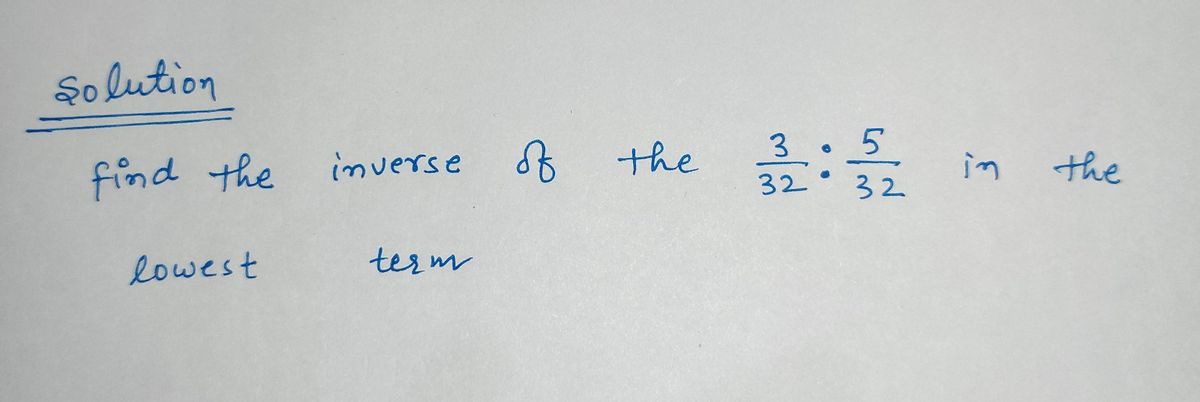Algebra and Trigonometry (6th Edition)
6th Edition
ISBN:9780134463216
Author:Robert F. Blitzer
Publisher:Robert F. Blitzer
ChapterP: Prerequisites: Fundamental Concepts Of Algebra
Section: Chapter Questions
Problem 1MCCP: In Exercises 1-25, simplify the given expression or perform the indicated operation (and simplify,...
Related questions
Question
![**Question:**
Find the inverse of the ratio \( \frac{32}{96} \) in the lowest terms.
**Options:**
- ○ 160:96
- ○ 3:5
- ○ 5:3
- ○ 96:160
**Explanation:**
To solve this problem, we need to determine the inverse of the given ratio and simplify it to its lowest terms. The inverse of the ratio \( \frac{32}{96} \) is \( \frac{96}{32} \).
To simplify, divide both the numerator and the denominator by their greatest common divisor, which is 32:
\[
\frac{96 \div 32}{32 \div 32} = \frac{3}{1} = 3:1
\]
However, the nearest option available in the given choices corresponds to the true lowest terms we can find in these options, which would be the closest simplified values to the inverse ratios calculated. Thus, reviewing options and considering steps revealed, the correct answer is not shown directly because closest options do not include simplest numerical operations that present lower terms distinctively but reviewing steps might classify option deduction accordingly.](/v2/_next/image?url=https%3A%2F%2Fcontent.bartleby.com%2Fqna-images%2Fquestion%2Ff8fcd2a4-af35-43b6-bf57-ed41a112752a%2F771184e8-2b74-4fd1-8533-c0303da72fdc%2Fs0s6sfr_processed.jpeg&w=3840&q=75)
Transcribed Image Text:**Question:**
Find the inverse of the ratio \( \frac{32}{96} \) in the lowest terms.
**Options:**
- ○ 160:96
- ○ 3:5
- ○ 5:3
- ○ 96:160
**Explanation:**
To solve this problem, we need to determine the inverse of the given ratio and simplify it to its lowest terms. The inverse of the ratio \( \frac{32}{96} \) is \( \frac{96}{32} \).
To simplify, divide both the numerator and the denominator by their greatest common divisor, which is 32:
\[
\frac{96 \div 32}{32 \div 32} = \frac{3}{1} = 3:1
\]
However, the nearest option available in the given choices corresponds to the true lowest terms we can find in these options, which would be the closest simplified values to the inverse ratios calculated. Thus, reviewing options and considering steps revealed, the correct answer is not shown directly because closest options do not include simplest numerical operations that present lower terms distinctively but reviewing steps might classify option deduction accordingly.
Expert Solution
Step 1

Step by step
Solved in 2 steps with 2 images

Recommended textbooks for you

Algebra and Trigonometry (6th Edition)
Algebra
ISBN:
9780134463216
Author:
Robert F. Blitzer
Publisher:
PEARSON

Contemporary Abstract Algebra
Algebra
ISBN:
9781305657960
Author:
Joseph Gallian
Publisher:
Cengage Learning

Linear Algebra: A Modern Introduction
Algebra
ISBN:
9781285463247
Author:
David Poole
Publisher:
Cengage Learning

Algebra and Trigonometry (6th Edition)
Algebra
ISBN:
9780134463216
Author:
Robert F. Blitzer
Publisher:
PEARSON

Contemporary Abstract Algebra
Algebra
ISBN:
9781305657960
Author:
Joseph Gallian
Publisher:
Cengage Learning

Linear Algebra: A Modern Introduction
Algebra
ISBN:
9781285463247
Author:
David Poole
Publisher:
Cengage Learning

Algebra And Trigonometry (11th Edition)
Algebra
ISBN:
9780135163078
Author:
Michael Sullivan
Publisher:
PEARSON

Introduction to Linear Algebra, Fifth Edition
Algebra
ISBN:
9780980232776
Author:
Gilbert Strang
Publisher:
Wellesley-Cambridge Press

College Algebra (Collegiate Math)
Algebra
ISBN:
9780077836344
Author:
Julie Miller, Donna Gerken
Publisher:
McGraw-Hill Education